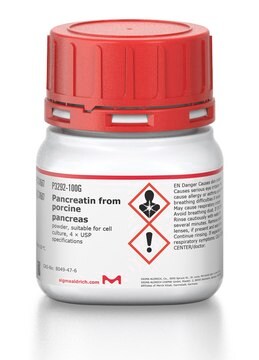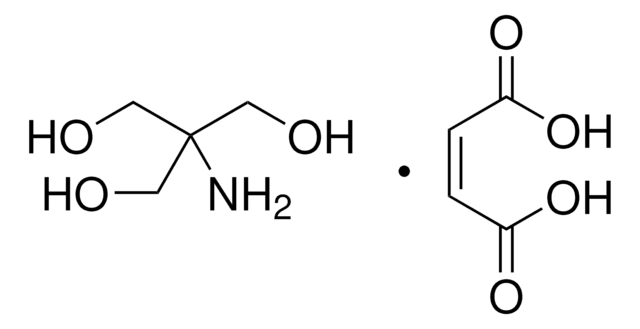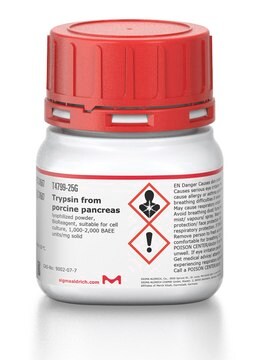P1625
Pancréatine from porcine pancreas
≥3 × USP specifications
Synonyme(s) :
Pancréatine from hog pancreas
Se connecterpour consulter vos tarifs contractuels et ceux de votre entreprise/organisme
About This Item
Numéro CAS:
Numéro CE :
Numéro MDL:
Code UNSPSC :
12352204
Nomenclature NACRES :
NA.54
Produits recommandés
Source biologique
Porcine pancreas
Niveau de qualité
Agence
USP (specifications)
Forme
powder
Activité spécifique
≥3 × USP specifications
Température de stockage
−20°C
Vous recherchez des produits similaires ? Visite Guide de comparaison des produits
Catégories apparentées
Application
Pancreatin from porcine pancreas is suitable:
- in a study to assess the treatment of steatorrhea by lipase supplementation therapy
- in a study to investigate treatment options for pancreatic diabetes in patients experiencing the decompensated stage of chronic pancreatitis
- to safely and effectively remove formalin-fixed tissues from arterial grafts without causing structural damage and loss in fiber integrity.
- to assess cleavage by digestive enzymes. It is used for in vitro digestibility analysis and to test the sensitivities of cellulolytic bacteria inhibitors
- along with amyloglucosidase for the in vitro digestion of starch in food samples
Actions biochimiques/physiologiques
La pancréatine contient des constituants enzymatiques, dont la trypsine, l′amylase et la lipase, la ribonucléase et la protéase, produites par les cellules exocrines du pancréas de porc. Cette combinaison d′enzymes lui permet d′hydrolyser les protéines, l′amidon et les graisses. La pancréatine est capable de convertir au moins 25 fois son poids de fécule de pomme de terre en glucides solubles en 5 minutes dans l′eau à 40 °C, de digérer au moins 25 fois son poids de caséine en 60 minutes à pH 7,5 et à 40 °C, et de libérer au moins 2 microéquivalents d′acide par min par mg de pancréatine à partir d′huile d′olive à pH 9,0 et à 37 °C.
Mention d'avertissement
Danger
Mentions de danger
Conseils de prudence
Classification des risques
Eye Irrit. 2 - Resp. Sens. 1 - Skin Irrit. 2 - Skin Sens. 1 - STOT SE 3
Organes cibles
Respiratory system
Code de la classe de stockage
13 - Non Combustible Solids
Classe de danger pour l'eau (WGK)
WGK 1
Faites votre choix parmi les versions les plus récentes :
Déjà en possession de ce produit ?
Retrouvez la documentation relative aux produits que vous avez récemment achetés dans la Bibliothèque de documents.
Les clients ont également consulté
Ruixin Zhu et al.
Nutrients, 11(3) (2019-03-17)
Plant origin, processing, and domestic preparation may affect the postprandial glycemic response (PGR) of starchy foods. The objective of this study was to examine the possibility of integrating domestically cooked non-cereal starchy foods commonly consumed in Northeast Asia into glycemic
R Raghunathan et al.
Food chemistry, 221, 1514-1521 (2016-12-17)
The objective of this study was to determine the molecular structure and properties of recently released cultivars of field peas [CDC Golden (CDCG), Abarth (ABAR), CDC Patrick (CDCP) and CDC Amarillo (CDCA)] grown at different locations in Saskatchewan, Canada. Starch
Z Zhang et al.
Biomaterials, 16(5), 369-380 (1995-03-01)
Chemical, physical and structural analyses of polymers from explanted vascular prostheses are frequently jeopardized because of incomplete removal of the encroaching host tissue. In this study, microporous polyurethane arterial prostheses implanted as a canine thoraco-abdominal bypass were explanted after 1
Konstantinos Korompokis et al.
Food & function, 10(8), 4674-4684 (2019-07-12)
Wheat grain roller milling disrupts starch containing endosperm cell walls and extracts white flour. Many wheat based food processes involve simultaneous use of heat and water which then cause starch to gelatinize and enhance its digestibility. In this study, the
T Nakamura et al.
Pancreas, 16(3), 329-336 (1998-04-21)
Pancreatic steatorrhea and pancreatic diabetes are the dominant symptoms of patients in the decompensated stage of chronic pancreatitis (CP). In this stage, the nutritional state is greatly disturbed and hypoglycemia and labile infection are involved. Pancreatic enzyme replacement therapy is
Notre équipe de scientifiques dispose d'une expérience dans tous les secteurs de la recherche, notamment en sciences de la vie, science des matériaux, synthèse chimique, chromatographie, analyse et dans de nombreux autres domaines..
Contacter notre Service technique









